Christmas Cactus Care: Holiday Cactus Made Easy
Christmas Cactus care is easy once you know the basics. This long-living, attractive houseplant can bloom year after year with just a little attention. Here’s a simple guide to growing and keeping your Christmas Cactus healthy during its blooming season and for the long term.
The Christmas Cactus — also called Holiday Cactus — is one of the best. I find this long-lasting succulent bloomer especially charming. Don’t toss it out after the holiday season is over. With proper care, it’ll continue to grow and flower beautifully for many years.
Christmas Cactus Care & Growing Guide
Christmas Cactus vs Thanksgiving Cactus
First off, let’s get a little technical for those of you who geek out on plants like I do. All the “Christmas Cacti” you see in this post are actually Thanksgiving Cacti, sometimes called Crab Cacti.
Most are labeled as a Christmas Cactus when you buy them — and that’s how most are sold in the trade. Growers time their blooms to start in late November, right after Thanksgiving, so it’s really a clever bit of marketing. You’ll spot them popping up in garden centers, big box stores, and even grocery stores before the holidays.
Whether you call them Christmas Cacti, Thanksgiving Cacti, or Holiday Cacti, the care is the same for this beautiful plant. The Thanksgiving Cactus blooms about 3–4 weeks earlier than the Christmas Cactus, making it especially popular as most people want to get a jump on their Christmas flowers.
A grower once told me that Thanksgiving Cacti also ship easier because they’re not as pendulous as Christmas Cacti — their stems are sturdier, and the leaves don’t break off as easily.
These days, you might see them sold under the all-inclusive name Holiday Cactus, but whatever you call them, they’re all beautiful, long-lived houseplants that brighten up the season.
Both the Thanksgiving Cactus and Christmas Cactus fall under the genus Schlumbergera. The Thanksgiving Cactus (Schlumbergera truncata) has little spine-like notches on the edges of its leaves — like tiny crab claws — which is how it got that common name. The Christmas Cactus (Schlumbergera bridgesii), on the other hand, has smoother, rounder leaf segments.
Bloom time is another difference between the two. The Thanksgiving Cactus typically flowers in late fall, around mid to late November through December, while the Christmas Cactus tends to bloom a few weeks later, in mid to late December or even January. The Easter Cactus (Rhipsalidopsis gaertneri) is a bit trickier to grow indoors and blooms in spring.

Size
Christmas Cacti are usually sold in 4-inch or 6-inch pots, though you’ll also see them in 6-, 8-, or 10-inch hanging baskets. Years ago, I spotted one in a commercial greenhouse in Connecticut with a stunning weeping form that was enormous — over six feet wide! With the proper care, a Christmas Cactus isn’t just a seasonal bloom; it can be an easy-care household favorite for decades.
Light Requirements
Christmas Cacti thrive in bright, natural light, ideally medium to high exposure — but keep them out of direct sunlight and hot windows. Too much light will cause their fleshy leaves to burn.
While they don’t do well in full sun, they still need plenty of light to grow, bloom successfully, and stay healthy year-round. Like many houseplants, indirect sunlight is their sweet spot.
One of mine grows on the island in my kitchen, and the other on a bench in my entryway. I live in the sunny Arizona desert, so I make sure to keep them out and away from west or south-facing windows.
Watering
They’re succulent plants. These epiphytic cacti differ from the desert cacti that I’m surrounded by here in Tucson. In their natural rainforest habitats, Schlumbergeras grow on other plants and rocks, not in the soil.
This means their roots need to breathe. You don’t want to keep them constantly moist, or they’ll eventually succumb to root rot.
Give yours a good drink and let all the excess water thoroughly run out of the drainage holes on the bottom of the pot. Allow the potting mix to dry before you water it again. Another reason not to keep them too wet is their susceptibility to fungus gnats. These pests don’t harm plants (or you), but they’re certainly annoying.
I water mine every 2-3 weeks in summer and every 3-5 weeks in winter. How often you water yours depends on several factors, including home temperature, the exposure it’s growing in, the pot size and type, and the soil mix it’s planted in. If you water one too often, plainly put, it’ll mush out. Conversely, too little water will cause it to shrivel and change color.
When your Holiday Cactus is blooming, water it a bit more often. After it has flowered, back off on the watering in winter. You can increase the watering frequency in spring and summer if need be.
My Christmas Cacti grew outdoors in terra cotta pots in partial shade in my Santa Barbara garden. Yes, they do grow outdoors year-round in temperate climates. I watered them weekly during the warmer months and occasionally in the winter, depending on the amount of rain we were receiving.
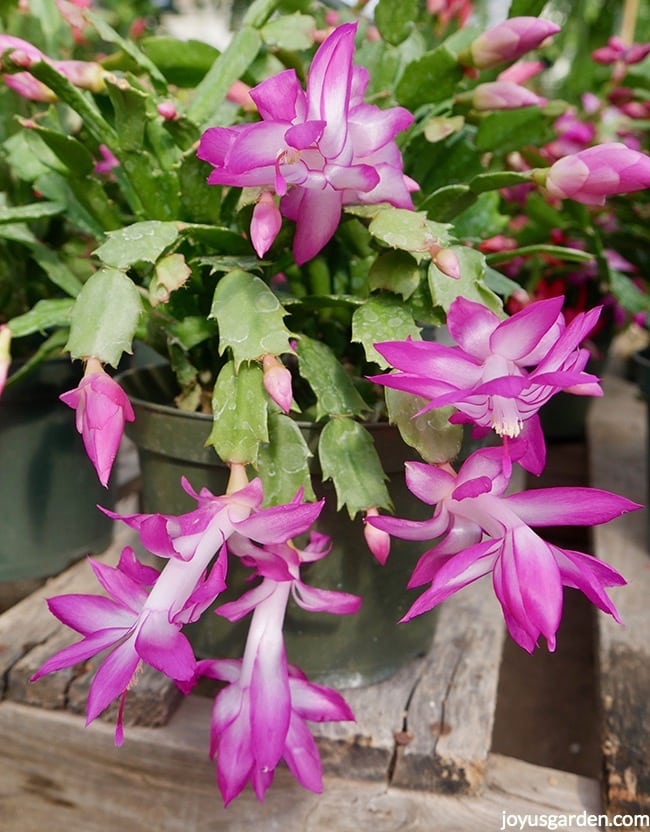
Temperature
In our homes, Christmas Cacti prefer warm daytime temps (65 – 75) with cooler nights. Cooler nights are essential when the plant is setting buds.
Santa Barbara winter temps could dip into the low 40s or high 30s, and mine growing outdoors were fine. If yours has been outdoors for the summer, bring it into the house before the temperatures drop too low. They can’t take a freeze and definitely not a blanketing of snow.
A few years ago, in mid-November, my Holiday Cactus in Tucson was nearly fully bloomed. Daytime temps were in the low to mid-80s, so I put it outside at night when it cooled to around 55°F to try to prolong the blooming period.
Keep in mind that warmer homes can speed up the blooming period, so avoid placing yours near heaters or fireplaces to help it bloom beautifully for longer.
Humidity
Christmas Cacti are tropical cacti, so they thrive in higher humidity levels — much like the rest of your tropical houseplants. Since our homes are often on the dry side, you may need to boost the humidity a bit.
I live in the desert and run two humidifiers in my dining room/living room and bedroom when the humidity inside drops below 30%. If yours starts to look not as robust, you can place it on a saucer filled with pebbles and water. Just make sure the bottom of the pot doesn’t sit in the water to avoid any risk of rot.
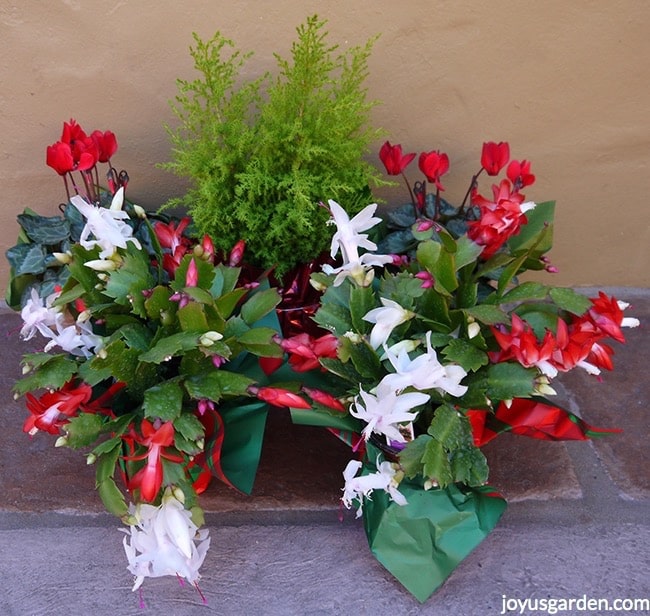
Fertilizing
I never fertilized my Christmas Cacti until I moved to Tucson. Outdoors, I simply amended with a topdressing of worm compost, and they looked great and flowered beautifully. Here in the desert, where it’s hotter and drier, I feed mine six times from early spring through summer using African Violet food.
Yours may not need fertilizing at all, but if you like to give it a boost, a balanced liquid houseplant fertilizer (such as 10-10-10 or 16-16-16) works. Apply it in early spring, early summer, and mid-summer or as needed to support healthy growth and blooms.
Soil Mix / Repotting
As I mentioned earlier, Holiday Cacti naturally grow on other plants, rocks, and bark — not in soil. In their natural habitat, they feed off leaf matter and debris, so they prefer a very porous mix with a bit of richness.
Good drainage is essential because the roots of a Christmas Cactus cannot stay constantly wet. I use DIY Succulent and Cactus Mix that is very chunky, along with a bit of potting soil and compost mixed in. The DIY mix contains coco chips and coco fiber. This environmentally friendly alternative to peat moss is pH neutral, increases nutrient holding capacity, and improves aeration.
Don’t rush to repot your Christmas Cactus — it actually blooms better when it’s slightly pot-bound. Most only need repotting every 3–6 years, depending on how fast they’re growing. If your cactus does need a new pot, the best time is 2–3 months after it finishes blooming, giving it plenty of time to settle in before the next flowering season.
I’ve done a post and video dedicated to Repotting Christmas Cactus to guide you step by step.

Pruning
The main reasons to prune a Christmas Cactus are if it needs taming because it’s spreading too much or if you want to propagate new plants.
When pruning, cut or twist off whole leaf/stem sections. You can easily identify them by the little indents between segments. Doing this carefully helps keep your plant healthy and encourages new growth.
Propagation
Like most succulents, a Christmas Cactus is easy to propagate. You can do it by taking single leaf or stem cuttings or by division. I’ve found that the best time to propagate is about 2 to 4 months after it finishes flowering. You’ll have new plants growing before you know it!
Division:
As you’ll see in the video guide, mine happens to be three plants growing together in one pot. I could easily separate them by gently pulling the plants apart or, if the roots are dense, cutting the root ball into sections with a clean knife. Each one can then be planted in its own pot using an appropriate mix.
Single Leaf or Stem Cuttings:
You can take individual leaf cuttings by removing leaf sections. I prefer to twist them off instead of cutting—whether it’s a single leaf or a short stem segment. If your plant is large enough, you can take longer stem cuttings for bigger starts.
Let the leaves or segments heal off (callus over) for about 4–7 days before planting. Then, stick them into the succulent and cactus mix about ½–2 inches deep, depending on their size. You may need to stake longer cuttings to prevent them from falling over. They’ll usually start rooting in 2–4 weeks, depending on your climate.
I covered pruning and propagation briefly here. If you’d like to dive deeper, you’ll find everything you need in my Christmas Cactus Propagation post.

Pests/Problems
Mine has only gotten a touch of mealybugs (they look like little bits of cotton), which I simply hose off. If that doesn’t do the trick, I dab them with a cotton swab dipped in a mix of 1 part rubbing alcohol to 2 parts water.
Go easy with the rubbing alcohol—it can burn the plant. It’s best to test it on a small section first and wait a few days to see how it reacts.
They can also be prone to spider mites. With any pest, take action as soon as you see it because they spread fast.
Root rot or fungus gnats can show up if the plant stays too wet. If the roots start to rot, the plant will wilt, wither, and eventually die—another good reason not to overwater your Christmas Cactus.
I always have insecticidal soap on hand because it effectively eliminates mealybugs, spider mites, and other pests.
Flowering
Holiday Cacti, like Poinsettias, are photoperiodic plants, which means they need short days and equal or more extended periods of darkness to bloom again.
They require about 12–14 hours of darkness each day to set those beautiful blooms. Start reducing the light about 6–8 weeks before you want them to flower — typically in early fall.
Keep them on the dry side during this process, as that helps encourage dormancy. Water sparingly every 3–5 weeks, depending on temperature, soil mix, and pot size.
Try to maintain temperatures between 50–65°F if possible, with cool nights around 50–55°F being ideal. If your home is warmer, they may need a longer period of darkness.
You can delay a Thanksgiving Cactus from blooming too early by keeping it cool (around 50–55°F). The flowers will open more slowly and last longer.
Moving your plant to a dark space like a closet or basement every night can be a bit of work, but covering it with a box might be a viable solution. If you have a spare room that naturally stays dark and cool, that works beautifully too.
Once buds start forming, move your plant back to that bright spot, resume regular care, and enjoy the show of blooms.
A common issue people have is flower buds dropping before opening. This usually happens when the plant is kept too wet or experiences environmental stress such as sudden temperature changes, too much sun, or cold drafts.
Flower colors vary widely — you’ll find them in red, violet, white, peach, orange, yellow, pink, fuchsia, and even bi-color.By the way, my Christmas Cacti growing outdoors in Santa Barbara bloomed beautifully on their own. Mother Nature handled the more extended periods of darkness for me in the fall!
After blooming, you can remove spent flowers by gently twisting them off while holding the leaf segment.
For a more in-depth guide on encouraging blooms year after year, check out How to get Christmas Cactus to bloom again.

Pet Safety
Bravo! Holiday Cacti are non-toxic to both cats and dogs. You and your pets can enjoy them worry-free.
Christmas Cactus Care FAQs
Can I plant my Christmas Cactus in a hanging basket?
You sure can! Those pendulous stems and blooms look gorgeous trailing over the sides. Just be sure not to use a pot that’s too large. A Christmas Cactus actually grows and blooms better when it’s slightly snug in its pot. Too much soil around the roots can stay damp too long, leading to root rot.
Why is my Christmas Cactus plant turning red?
If your Holiday Cactus is changing color — usually to a reddish, orangish, or brownish hue — it’s a sign of stress. The most common causes are too much direct sunlight or insufficient water. Move it to bright, indirect light and water when the soil feels almost dry. Once conditions improve, the color should gradually return to normal.
Can I grow a Christmas Cactus from a single segment?
Yes. A Christmas Cactus can grow from just one stem segment. It takes a bit of patience for those single segments to become full plants, but it’s a fun and rewarding project — especially to do with kids.
Why are my Christmas Cactus flowers a different color this year?
Environmental changes, like light or temperature, can affect flower color. Hybrid plants sometimes revert to their dominant color, so the blooms may look a bit different from last year.
Does my Christmas Cactus need a rest period after blooming?
Yes. Like most flowering plants, it benefits from a short rest after blooming before putting out new growth. During this time, water a bit less and keep it in bright, indirect light to help it recharge.
Other Christmas Cactus Care Guides: Getting Christmas Cactus To Bloom Again, Christmas Cactus Repotting, Christmas Cactus Propagation, Christmas Cactus Flowering More Than Once A Year, Christmas Cactus Leaves Turning Orange, & Answering Your Questions About Christmas Cactus
Christmas Cactus Care Video Guide
Conclusion: With proper Christmas Cactus care, you’ll enjoy those gorgeous blooms and the lasting beauty of a Christmas Cactus houseplant year after year. It’s so easy and rewarding!
Happy gardening,

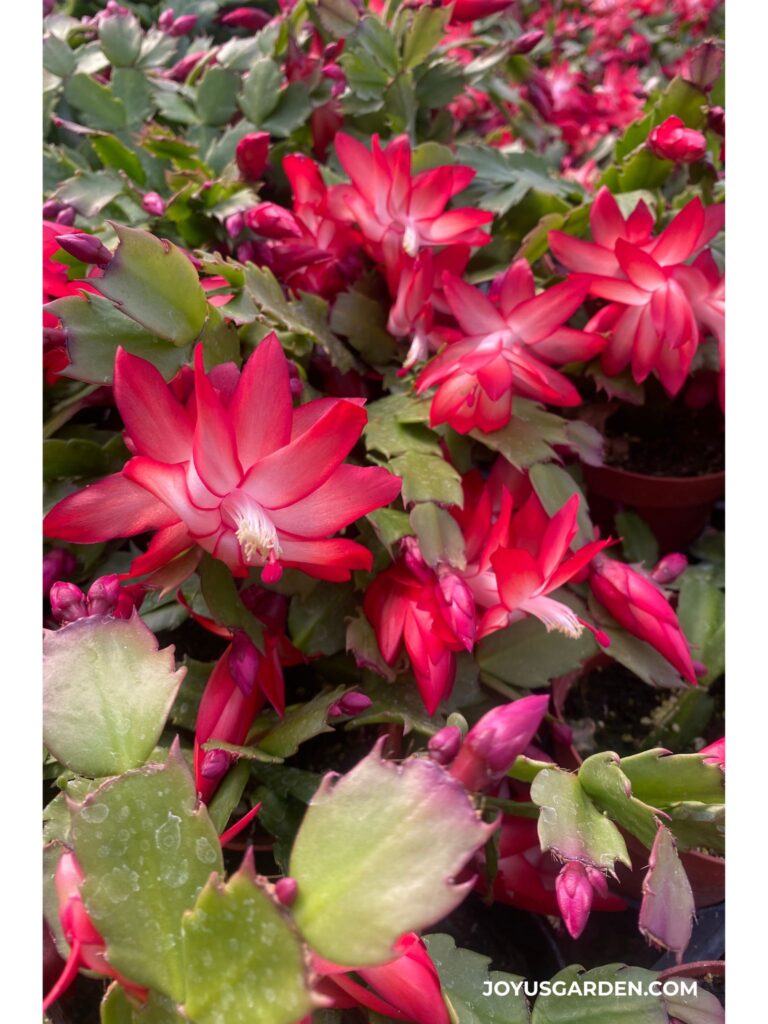


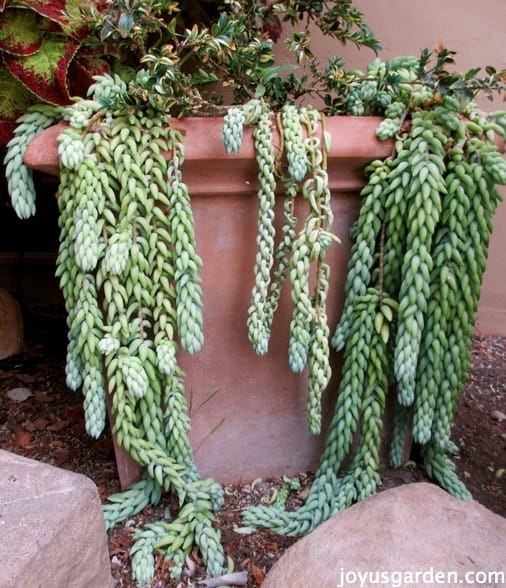
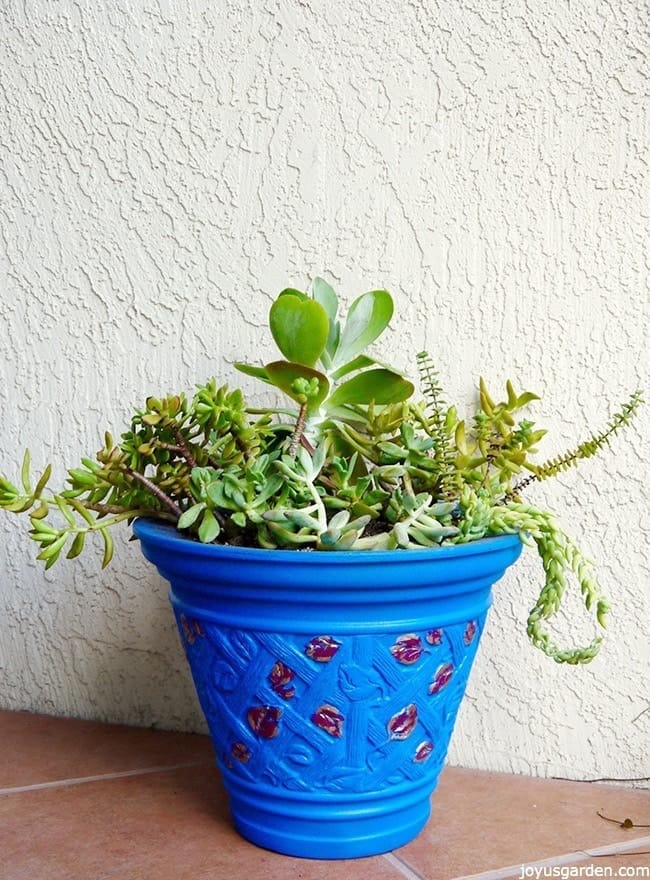
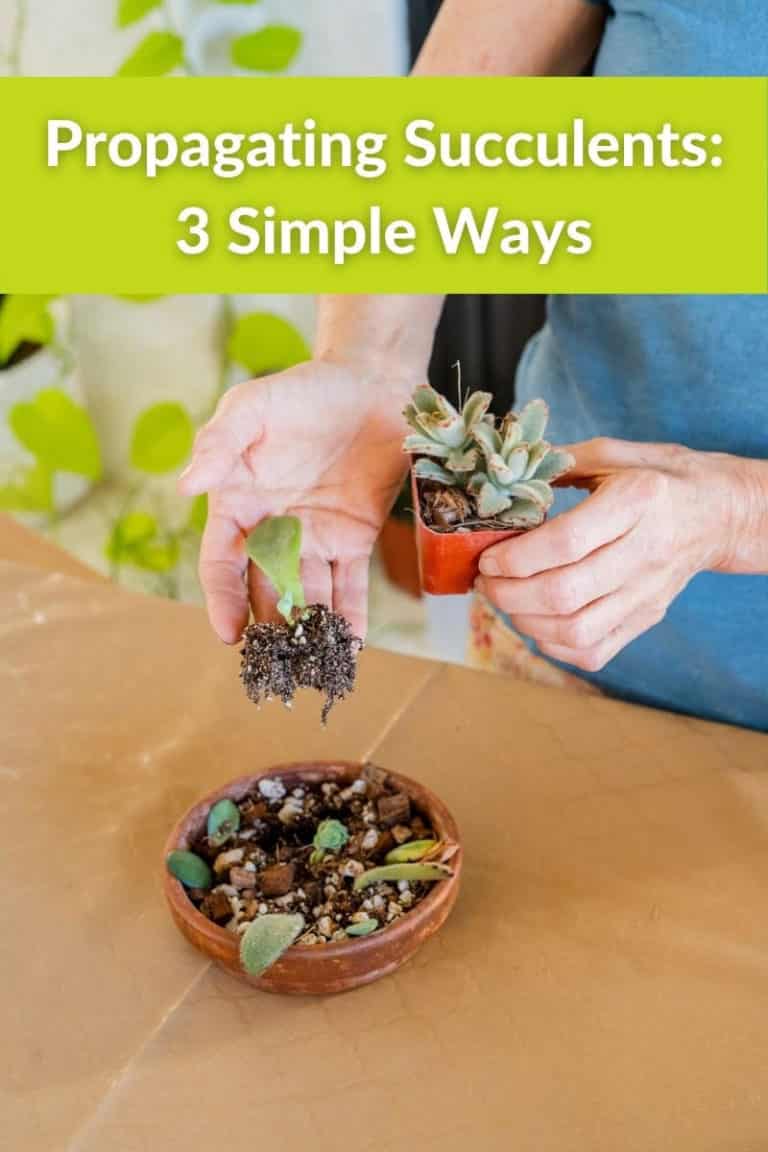


UPS left a gift holiday cactus on my porch, with no warning, and it partially froze., overnight. One side of it seems to be surviving, but the other side has dead, limp leaves. Should I cut these off? I would appreciate any suggestions.
Hi Carol – You can cut away those dead, limp leaves. If there is a node or 2 towards the base which isn’t dead & limp, then leave it/them. The roots may not have frozen so new growth may appear as spring approaches. The good news is that HC propagates very easily so as the other side grows, you can take cuttings to fill in the plant. I’m doing a post on propagating 1 in the next 3-5 weeks. Nell
My Christmas cactus is about 4 years old and puts on a show when in bloom. Last year, for the first time, I noticed it re-budding, as the blooms were starting to dry out but the buds all dried out and dropped. This year, again, it’s re-budding but the buds look as if they might survive and go into full bloom, is that usual?
Hi Gloria – Yes, it can happen. The buds falling off are due to environmental stress like change in temperature or light exposure, air too dry, or if the plant was moved while those buds were setting. Those are the reasons I know of. Nell
Hi Carol-I was wondering if these would grow in the water beads.
Not that I’m aware of Jackie. I propagate mine in mix but I know some people do it in water. In regards to growing for the long haul, I’d stick to mix. Nell